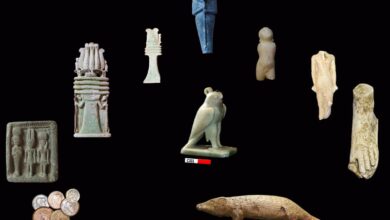
Stunning gold jewelry, made under Queen Nefertiti’s reign, has been discovered inside two Bronze Age tombs hidden for 3,000 years in Cyprus, The Daily Mail reported.
A pure gold necklace in the shape of a lotus flower with inlaid gemstones was found, similar to the jewelry worn by the ancient Egyptian queen of the Eighteenth Dynasty.
Archaeologists say that this discovery and other decorations tell the story of the extensive trade of those in Cyprus with Egypt.
The tomb is one of two discovered in 2018 on the small Mediterranean island; archaeologists from the University of Gothenburg are in awe of the discovered wonders inside.
In addition to the fine jewelry, archaeologists also discovered remains from 155 individuals and a treasure trove with 500 objects in the two tombs.
Both structures were in use for hundreds of years, from about 1500 to 1350 BC, and skeletons and funerary objects were also found.
One of the skeletons belonged to a five-year-old boy, who was most likely part of an elite family, buried with lots of jewelry, including a solid gold crown and beaded necklace.
The team has been working at the site since 2010, but only discovered the two tombs three years ago.
Burial structures constitute underground chambers, each containing a large number of human skeletons.
“Managing the finds required very delicate work spanning over four years, since the bones were extremely fragile after more than 3,000 years in the salty soil,” the archaeologists said in a statement.
Once the team was able to examine the remains and artifacts, they discovered hundreds of skeletons and treasures. One particularly important find is a cylinder-shaped seal made of hematite, with a cuneiform inscription from Mesopotamia (present-day Iraq), which archaeologists have been able to decipher.
“The text consists of three lines and mentions three names. One is Amurru, a god worshiped in Mesopotamia. The other two are historical kings, father and son, who we recently succeeded in tracking down in other texts on clay tablets from the same period, i.e. the 18th century BC.
We are currently trying to determine why the seal ended up in Cyprus more than 1000 kilometers from where it was made,” Professor Peter Fischer, head of the excavation team, said in a statement.
Gold jewelry, beetle-shaped amulets with hieroglyphs and the remains of fish imported from the Nile Valley tell the story of the intense trade with Egypt.
In comparison with similar finds from Egypt, archaeologists have also been able to determine the history of the jewelry.
“The comparisons show that most of the objects are from the time of Nefertiti and her husband Echnaton around 1350 BCE. Like a gold pendant we found: a lotus flower with inlaid gemstones. Nefertiti wore similar jewelry,” Fischer said.
The next step in this amazing feat will be analyzing the DNA of the skeletons, Fischer added. “This will reveal how the different individuals are related with each other and if there are immigrants from other cultures, which isn’t unlikely considering the vast trade networks,” he mentioned.




